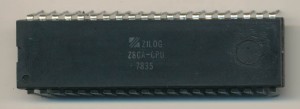
AMD AM2901ADC – 1977
In August 1975 AMD introduced the ‘100 ns Bipolar microprocessor.’ This was a bit-slice device. Essentially a 4-bit ALU (like a 74181) with functionality (scratch pad memory and accumulator register) to make it work as a processor that could be scaled to any bit width (using the 2909 sequencer and 2910 controller). Being made in bipolar allowed for the high speed (10MHz at the time was pretty quick). The introduction of the 2901 also marked the beginning of the end to the competition int he bit-slice arena. A combination of marketing, second-sourcing, and a good product allowed AMD to completely dominate the bit-slice market. Even today most bit-slice designs are based on the 2901 from 35 years ago.
At the time there were several other bit-slice processors on the market. Intel had the 3002 (a 2-bit design), National’s IMP-8 and IMP-16, and the original TTL 74181 were all bit-slice devices. MMI (which AMD bought in the 1980’s) had introduced the 6701 4bit slice in 1974, a full year before AMD’s 2901. TI had the SBP0400A and Motorola the MC10800 (in ECL – 1976). So why with all this competition did AMD come to dominate?

Raytheon AM2901ADC – 1980
Second Sourcing
Second sourcing is the licensing of a design to other companies for them to manufacture, market and sell it. Sometimes its simply a license to manufacture, sometimes it comes with technical assistance, or even complete mask sets to make the device. There are three main reasons this is done (or was done back in the day)

Guaranteed Availability.
In the 1970’s making IC’s was a relatively new process, one with many bugs, and often reliability issues. Having a second source was a must to get a big design win. A system design would not want to design a system around a chip that may end up not being available, or not be available in the quantities needed. Having a second source to get the IC from alleviated this problem. It gave system designers a stable supply, regardless if the primary source could not keep up, or had a problem.

Distribution
Second-sourcing helped solve distribution problems as well. A company may have an excellent design, but no way to sell it. Often this was a geography problem. American companies did not initially have a large presence, or distributors set up, in Europe or Japan. An American company would often second-source a design to a European company (such as Siemens or Thomson) solely to get their design distributed in that area.

Marketing
One of the keys to a processors success is design wins. It can be the best processor on the market,. but if no one uses it, it will fail. Having additional companies make, and market the processor vastly increased its exposure. Second-source companies would also typically make development systems, and other support tools, as well as vast documentation for the processor. This helped ensure that engineers knew about the processor, how to use it, and whee to get it, ensuring its winning of more sockets.

Soviet Electronika 1804VS1 – 2901 Clone – 1988
AMD clearly understood the importance of second-sourcing. In November 1975, just months after the 2901 was released, they designed an agreement with Motorola to make the 2901. In December, they signed up Raytheon, and in March of 1976 AMD signed an agreement with the SESCOSEM division of Thomson-CSF, to make and distribute the 2901 in markets outside the US and Japan. In June 1976 AMD amended their agreement with Motorola to include more technical assistance, ensuring Motorola could get the 2901 to market. In September 1976 MMI canceled the 6701, as they were unable to compete. MMI had no second-sources for the 6701 which likely led to its failure.
As the years went by, AMD added more second-sources, and dropped a few. Eventually coming to completely dominate the bit-slice market. The Soviets began to copy the 2901 around 1985 (not particularly legally but they did what they had to) and continued to do so until well into the 90’s.
| Year |
Second Sources |
| 1975 |
Motorola |
| 1976 |
Motorola, Raytheon, Thomson |
| 1977 |
Motorola, Raytheon, Thomson, National |
| 1978 |
Motorola, Raytheon, National, Fairchild, NEC, Signetics, Thomson |
| 1980 |
Motorola, Raytheon, National, Fairchild, NEC, OKI (MSM8821?), Thomson |
| 1982 |
Motorola (2903), National, Fairchild, NEC, Thomson |
| 1985 |
National, Thomson, Cypress, USSR |
| 1990 |
Cypress, IDT, Thomson, National, USSR |
| 1995 |
Cyrpress, IDT, WSI, Thomson, Russia |

Innovasic IA59032 – 8 x 2901 – 2003
AMD also made the AM29C101 which was 4 2901s in a single chip, producing a 16bit processor. Cypress manufactured a copy of the 29C101 called the CY7C9101
Several other companies also designed multiple 2901s into a single chip. WSI (and later InnovASIC) designed the 59032, which has the equivalent of 8 2901s to form a 32 bit slice and the 59016 which was 16bit slice (4x 2901). IDT designed the 49C402 which was also a 16 bit slicer. Today the 2901 is still in wide use, and while not generally used for new designs, it still powers a vast amount of electronic equipment that still is in use. InnovASIC still manufactures the 2901 (in 59032 form) to this day.





 In 1993 Moore designed the F21, again a 21 bit CPU based on the MuP21, designed to run Forth, and including 27 instructions. It was fab’d by Mosis on a 0.8u process. The F21 microprocessor contains a Stack Machine CPU (with a pair of stacks like the NC4000), a video i/o coprocessor, an analog i/o coprocessor, a serial network i/o coprocessor, an parallel port, a real time clock, some on chip ROM and an external memory interface. Performance was 500 MIPS (this was an asynchronous design, so ‘clock speed’ is a bit of a misnomer) and transistor count had risen to about 15,000. The F21 was made up through 1998, however the design continued to evolve. A version of the F21 was developed called the i21, originally for Chuck Moore’s iTV Corporation, which was one of the very first set top Internet appliance companies. It integrated additional featured such as infrared remote interface, modem DMA interface and a keyboard DMA interface. The F21 scaled well, and was tiny, remember, only 15,000 transistors, which at 0.18u takes up a VERY small die, and allowed performance to hit 2400MIPS @ 1.8V. One could put a very large amount of these on a single die…..
In 1993 Moore designed the F21, again a 21 bit CPU based on the MuP21, designed to run Forth, and including 27 instructions. It was fab’d by Mosis on a 0.8u process. The F21 microprocessor contains a Stack Machine CPU (with a pair of stacks like the NC4000), a video i/o coprocessor, an analog i/o coprocessor, a serial network i/o coprocessor, an parallel port, a real time clock, some on chip ROM and an external memory interface. Performance was 500 MIPS (this was an asynchronous design, so ‘clock speed’ is a bit of a misnomer) and transistor count had risen to about 15,000. The F21 was made up through 1998, however the design continued to evolve. A version of the F21 was developed called the i21, originally for Chuck Moore’s iTV Corporation, which was one of the very first set top Internet appliance companies. It integrated additional featured such as infrared remote interface, modem DMA interface and a keyboard DMA interface. The F21 scaled well, and was tiny, remember, only 15,000 transistors, which at 0.18u takes up a VERY small die, and allowed performance to hit 2400MIPS @ 1.8V. One could put a very large amount of these on a single die…..













